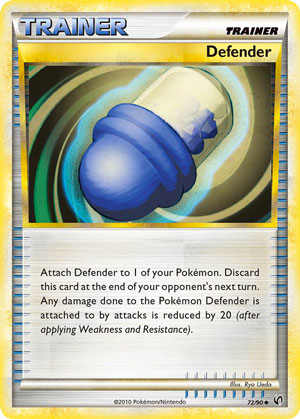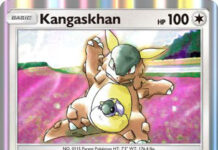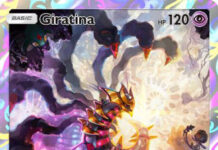
Defender – Undaunted
Date Reviewed: September 30, 2021
Ratings Summary:
Standard: N/A
Expanded: N/A
Legacy: 2/5
Theme: 3/5
Ratings are based on a 1 to 5 scale. 1 is horrible. 3 is average. 5 is great.
Reviews Below:

Otaku
Defender is certainly the throwback, predating even me! Released into arcades in 1981, Defender was developed by Williams Electronics and we all know that I know this isn’t the Defender we’re reviewing today. Defender is a Trainer-Item that you attach to one of your Pokémon in play. At the end of your opponent’s next turn, Defender will discard itself. During the time in between, Defender reduces the damage taken by the Pokémon to which it is attached from any and all attacks, but after applying Weakness and Resistance. Yes, all attacks; Defender can reduce self-damage from your own attack during the turn it was attached, and then reduce the damage you take from an attack by your opponent’s Pokémon during their turn. One can also play more than one Defender at a time to the same Pokémon and the effects will stack.
Defender was originally released as Base Set 80/102 (released January 9, 1999), then was reprinted as Base Set 2 109/130 (February 24, 2000), and yet again as HS – Undaunted 72/90 (August 18, 2010). All three of these printings just label Defender as a “Trainer”, because the term “Item” wasn’t used until the Black & White-era. Defender has always been unusual in that it is an Item you attach to your Pokémon but is not a Pokémon Tool or Technical Machine. It is also worth noting that Defender has received an erratum. However, I don’t really need to list the original effect because the new wording functions the same as the wording from the Base Set and Base Set 2 releases; at least some of the HS – Undaunted printings erroneously state that Defender only reduces damage from attacks by your opponent’s Pokémon.
Defender was legal for the 2000, 2001, 2011, and 2012 Standard Formats, and also the soon-to-retire PTCGO’s Legacy Format and Theme Formats. If you are familiar with the Standard Format, I’ve got some explaining to do. The term “Standard Format” was first used by WotC to refer to what it means now; the default format for Organized Play. Unfortunately, when set-rotation was introduced, there was much confusion with the player base. Most players who knew what Organized Play even was thought that “Standard” meant “Base Set-On”, what we know refer to as the “Unlimited Format”. We then understood the “new” Rocket-On Format as being the “Modified” Format… and so the Standard Format was misnamed until 2014 Season. Kind of like how so many still list the beginning and ending years of the Format instead of just the ending year, the way TPCi does e.g. we’re currently in the 2022 Standard Format and not the 2021-2022 Standard Format.
Yes, I really need to write a separate article explaining this, so I can stop doing it here in the Card of the Day. Defender was a very good card in the early days of the game. A staple? Exactly how competitive such decks were is hard to say. In the present, there is still room to debate how competitive a deck truly is, because it isn’t like we’re constantly having the best players run every possible match-up. When we discuss the Pokémon TCG past, we have less surviving results, and the results we do have can be questioned because of mass card shortages plus a player base without the current 20+ years of collected Pokémon TCG wisdom and general knowledge.
All I can relay now is what I remembering using, seeing, or at least having heard about, give or take a few “newer” decks built using older cards. Nope. As good as its opposite, PlusPower? Nope again. It was a card that was functional in most decks, however, and quite good in certain ones. Namely, Defender was good for ye old stall decks, and in those using an attacker that did self-damage. Cards like Arcanine (Base Set 23/102; Base Set 2 33/130; Legendary Collection 36/110) and Chansey (Base Set 3/102, Base Set 2 3/130) had expensive attacks that – for the time – hit hard but were hampered by self-damage. Besides healing, Defender was there to soak some or all of that self-damage plus whatever your opponent threw at them the next turn. Unless, of course, they used a workaround like Gust of Wind. Even some Haymaker lists included Defender, because a lot of the Pokémon in it just needed to soak an extra 10 or 20 damage to survive typical attacks of the era.
Facilitating this was the nature of the early days of the game. You had Computer Search in its non-Ace Spec form, Item Finder (non-Ace Spec Dowsing Machine), Professor Oak (Professor’s Research as an Item), Bill, and/or Erika. Note that those last two are Supporters in the present due to reprints, but were “normal Trainers” a.k.a. Items during this era of the game. Okay, now fast-forward to the final printing of Defender. I was just returning to the game when it released, and so I really don’t have first-hand knowledge of how well it performed. What I can do is consult the commemorative World Championship Theme Decks that released for those years and… no hits. Not one of the eight decks preserved this way used Defender. Power creep may have made the protective effect of Defender insufficient, but -20 was still enough to save a Pokémon around this time…
…just look at the popularity of contemporaries like Eviolite and PlusPower. Which, I think, provide the real answer: Defender just couldn’t out compete such cards for deck space. Eviolite was basically Defender in Tool form, and that only worked for Basic Pokémon. Though Defender didn’t eat up your Tool slot, it also didn’t stick around. You could drop Eviolite onto a Benched Pokémon that wouldn’t need it until a later turn. Do that with Defender, and you just wasted it. Speaking of narrow margins, doing +10 damage (or up to +40) meant some decks would use PlusPower in the space that could have gone to Defender, something that also happened back in the early days of the game. If Defender were re-released today, I’m just not sure if it would be worth it. Probably only for certain stall decks or those with self-damaging attackers, which is still something. I’ll still score for the PTCGO’s Theme and Legacy Formats… but with the PTCGO being replaced, it seems these two Formats will be replaced.
Ratings
- Standard: N/A
- Expanded: N/A
- Legacy: 2/5
- Theme: 3/5
We would love more volunteers to help us with our Card of the Day reviews. If you want to share your ideas on cards with other fans, feel free to drop us an email. We’d be happy to link back to your blog / YouTube Channel / etc. 😉
Click here to read our Pokémon Card of the Day Archive. We have reviewed more than 3500 Pokemon cards over the last 17+ years!



